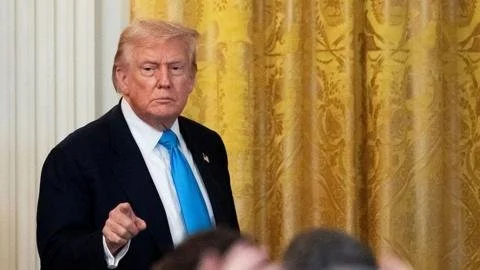Trump's Bold Move: A 15% Tariff on South Korea and Its Far-Reaching Implications
President Donald Trump recently announced a 15% tariff on imports from South Korea, heralding it as a ”full and complete trade deal”. This significant development comes just a day before the 1 August deadline for countries to secure agreements with the US, or face even higher tariffs, as South Korea was at risk of a 25% levy. Pressure was mounting on Seoul following Japan’s previous success in negotiating favorable terms with the US.
Key aspects of the deal include South Korea’s promise to invest $350 billion into the US, aimed at improving bilateral trade relations — a move regarded as a significant success by the South Korean administration, especially considering their record trade surplus of at least $56 billion with the US last year.
The 15% tariff will specifically affect South Korea’s main exports to the US, which include cars and semiconductors. However, products like steel and aluminium will incur higher taxes at 50%, aligning with global tariffs set by President Trump.
Despite the tough terms, South Korean leader Lee Jae Myung was optimistic, believing that the deal positioned South Korea favorably compared to other nations. An important aspect of the negotiation was South Korea’s ability to maintain strict controls over its markets for rice and beef, avoiding concessions that could jeopardize domestic agriculture — a potential flashpoint, as farmers opposed any relaxation of these rules.
The investment breakdown reveals that $150 billion of South Korea’s financial commitment will go towards shipbuilding in the US, a strategic decision to assist the US in bolstering its declining naval capabilities. This investment corresponds with South Korea’s robust shipbuilding sector, which is second only to China.
Much of the other pledged monetary support is thought to stem from previous commitments made to the US during the Biden administration but have yet to be fulfilled. These investments aim to bolster US production in cars, semiconductors, and electric vehicle batteries.
Notably, the deal does not compromise South Korea’s military alliance with the US, nor does it affect the extensive financial support Washington provides to defend South Korea against threats from North Korea. Nonetheless, the looming threat from Trump to withdraw US troops from Korea unless payments for protection increase casts a shadow over future negotiations.
Trump’s recent tariffs and trade policies are part of a broader agenda to enhance American manufacturing and protect local jobs. However, critics argue that such measures are causing economic instability globally, with rising costs for consumers in the US. The intricacies of these tariffs and international trade dynamics continue to create a complex landscape for both domestic policy and foreign relations.

